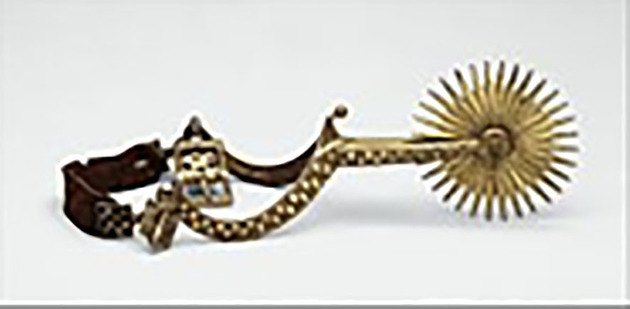
Museum Archives May 2020: Porkers, Spurs and other useful disagreements
There were, for instance, a series of court cases between 1086 and 1108 in which the lords of Bramber Castle – the de Braose family – wrangled with the abbot of Fecamp, to whom the manor of Steyning belonged, over who had the right to the tithes and the burial of the dead in the parishes of Bramber and Beeding and to the tolls on boats going up the river to Steyning.William the Conqueror, William Rufus and Henry I, in turn, sat in judgement.
Eventually it was agreed that de Braose and the Abbot of St. Florent, who held the Priory of Sele in Beeding should grant 'to the Abbot of Fecamp the Church of St. Nicholas of Bramber Castle, with its burials and offerings and the tithes of Staninges and of Bedlingetona [Bidlington] – in sheaves and cheeses and wool and lambs and porkers and calves and flax and hemp.'
On the other side of the parish, where the boundary between Steyning and Wiston crosses Mouse Lane, there was a very different but quite curious dispute.
The boundary descending from the Downs meets the lane not far from the Round Robin gate into Wiston’s parkland. But it then zigzags back down the lane and leaves in the direction of Wiston Pond about 150 yards closer to Steyning.
For a while, some hundred years ago, different authorities were responsible for the upkeep of the lane on either side of the boundary line and no one could agree just who was responsible for the little zigzag section which, consequently, became a sort of ‘no man’s land’ and fell into disrepair.
If, in the past, you had followed the parish boundary towards Wiston Pond you would have seen, not far off, the old manor house of Little Buddington (now demolished).
It had been in various hands over the centuries. It became part of the de Braose lands after the Conquest but was then granted to Henry St. Valerie in 1130 at an annual quit-rent - [a rental freeing him from feudal obligations] - of a pair of gilt spurs - [a knight’s spurs being gilded; a squire’s silvered] - with a value of sixpence.
The parchment roll said 'a paire of spores over gilte price of vjd [6d] at the Castell of Brembere'. When the manor was transferred in 1230 to the Abbess of Godstow for 'thre score markes in silver' [i.e. £40], the obligation for the Abbess to deliver the gilded spurs (or sixpence), in person, to Bramber Castle remained – presumably continuing until Henry VIII appropriated monastic property in 1540.
If you then follow the boundary beyond Wiston pond and cross the main road you soon reach Horsebrook Cottage following an old track which, in 1373, was the subject of some dispute.
'Be it known' said the Bishop of Chichester 'that the Lord Bishop has, shall have and was wont to have, his right of way for himself, his household, his horses, gear, packhorses and other carriages, and for any of his household on horse or afoot . . . through the pasture called Hursebrok and the meadow of the Abbess of Godstow . .'
That Abbess again. Near Horsebrook she got into a dispute with a neighbouring farmer, William Berneval, over a ditch which separated his field from hers. With acrimony on both sides the nunnery eventually acquired the right to it at a cost of 5s 6d, in settlement 'of any clayme that he (Berneval) had in a diche, of which stryf and ple was in the Courte of Brambre, which is diched bitwene the croft called Herbelot and the culture called Hamehore.'
The immediacy of these records – of disputes, of agreements and of 'stryf' with their references to porkers, gilded spurs, rights of way, ditches, and much else – all help to bring Steyning’s past to life.

